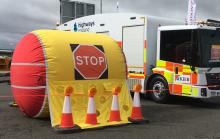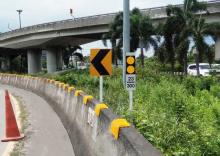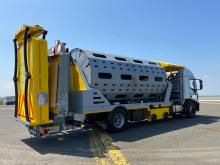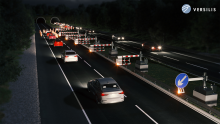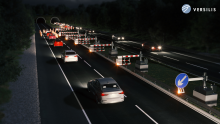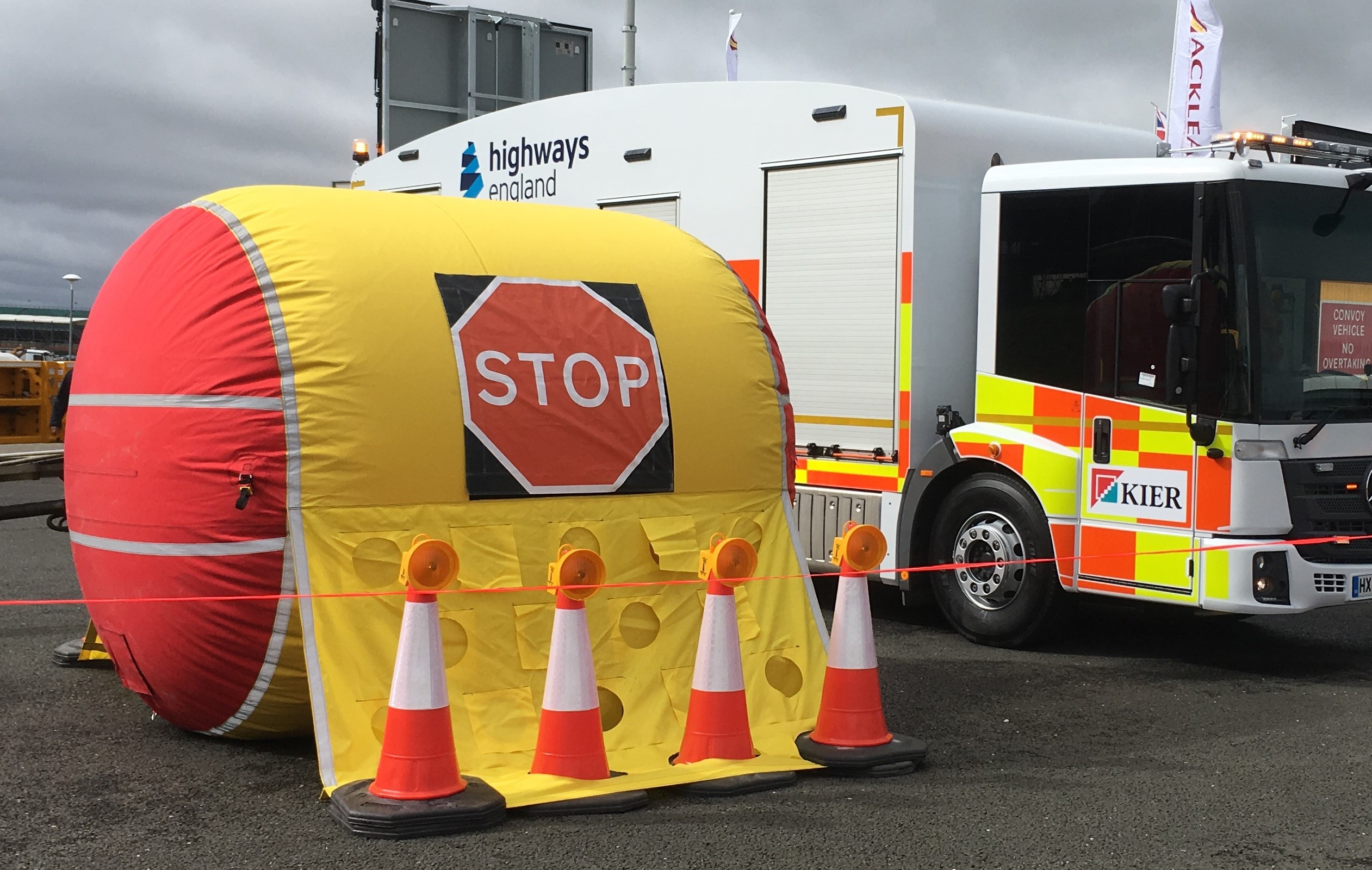
Highways England has been trialling an inflatable work zone safety barrier that can be put up in 10 minutes to warn approaching drivers to slow down.
The agency said that the airbag – “large, bright and very visible” - is being trialled in the Midlands region in a bid to reduce the number of motorists that mistakenly drive into work zones. Vehicles often enter work sites on motorway slip roads as drivers try to exit the highway.
“On average, our road workers report around 240 incidents of vehicle incursions each month,” said Lisa Maric, Highways England’s supplier relationship manager in the West Midlands region. “It is a far too frequent a hazard for our workforce going about their daily job – and the consequences could be fatal.
The inflatable barrier is in addition to the usual directional warning cones and signs, adding another layer to the traditional traffic management to influence drivers' behaviour and prevent vehicle incursions. The trial is costing around £95,700 (€110,500 / US$134,000), according to Highways England.
Collaboration
Development of the bag was a collaborative effort, said Maric. The agency worked with road maintenance partner Kier Highways and with Highway Resource Solutions**, a UK engineering company that specialises in designing safety solutions to prevent injuries and fatalities in temporary work zones.
The bag is a prototype made by Big Air Bag, based in the Netherlands. The material is toughened PVC – polyvinylchloride, averaging 3mm thick and up to 5mm thick at stress points. When inflated it stands around 2.5m high, 2.5m wide and nearly 3m long.
“We searched the Web to identify suppliers,” said Tom Tideswell, head of innovation at Kier Highways. “Some UK air bag manufacturers were making mostly bouncy castle bags. We went with Big Air Bag because they had created the large safety landing air bags for Red Bull Extreme sports.”
To inflate the bag quickly, Kier converted a leaf-blower and there are two inflation holes should two blowers be needed to even more quickly inflate the bag faster. “We were considering using a generator but we wanted to ensure there isn’t any additional inflammatory liquids on site in order to accommodate the COSHH [Control of Substances Hazardous to Health ] regulations. The blower we use has a rechargeable battery and is a very basic model.”
Importantly, when deflated it is easily stored in a simple large travel bag and can be driven in a car or small truck to the next location if need be.
The design of the bag is such that each would be interchangeable, allowing several to be locked together in alignment if a larger warning was required. But only one is on trial to make sure the bag’s physical performance is there and it has been moved around from site to site, depending on what warnings are needed for an upcoming traffic re-routing. “It is important to note that this bag is in addition to existing road closure safety systems like traffic management signage, directional cones,” said Maric.
But to be absolutely clear, cautioned Tideswell, there will not likely be wayward vehicles bouncing off the airbags every which way and possibly back into moving traffic or maintenance workers – the very people the airbag is designed to protect. Indeed, the bag has not been crash-tested at all. “The clearly visible bag is to act solely as a visual deterrent, a type of warning sign in itself.”
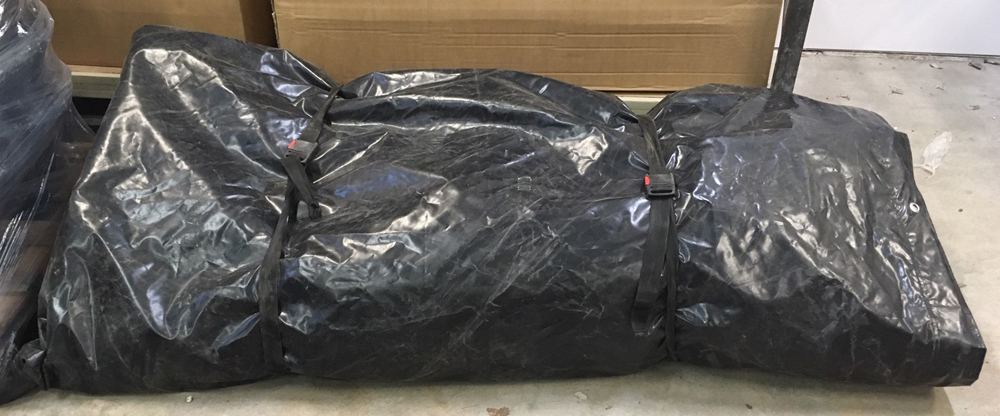
Highways England has done quite a few studies of mental and anticipation reaction of drivers. The bag is the usual warning colours of red and yellow with white fluorescent reflective marking, like the white markings on traffic cones. “Because the bag is close to 3m tall and between 80-90% of vehicles that cut through work zones are cars, the bag should appears obvious and intimidatory to drivers,” said Tideswell.
Wind tunnel
There is a skirt at the bottom of the bag upon which a series of traffic cones sit to secure the bag in place. “We actually put it through a wind tunnel at MIRA to ensure that it didn’t blow away like an air foil,” said Tideswell. HORIBA MIRA, formerly the Motor Industry Research Association, is an automotive engineering and development consultancy company headquartered Warwickshire, UK. It provides product engineering, research, testing, information and certification services to the automotive sector.
Another row of cones sits in front of it to enhance the warning to drivers. If a vehicle did impact the bag the impact pressure would split open for slits to quickly deflate the bag so it doesn’t bounce around the worksite and cause secondary damage.
Collaboration has been key to the airbag trials. “A lot of our ideas come from the bottom up, from our suppliers and the supply chain, operatives who are out there on the site,” said Maric. “Safety is Highways England’s number one imperative.”
Tideswell, with 15 years in the sector knows only too well the perils of highway working. Now, as head of innovation for Kier Highways, he is directly responsible for coming up with new ways of safer working. Severe injuries, while not common, do happen, he says, and some employees have had life-threatening injuries. Other workers have not returned to any work because of their injuries. However, no matter what precautions are taken, highway worksites will remain dangerous for even the most experienced personnel.
“As a 17-year-old highways inspector, I used to walk up and down the M6 [motorway], A28 and other roads finding defects and noting potholes. The amount of abuse you get is outrageous,” he says. “On the A50, people would throw things at me in the belief that, because I was wearing yellow safety clothing, I was causing the traffic problems.”
Last autumn, Highways England embarked on an awareness campaign to show the public just how dangerous highway maintenance can be. It is not only the threat of wayward vehicles hurtling through worksites, it is also the physical threat by drivers who are irritated at being delayed. Indeed, one of the videos posted on the Highways England website shows drivers getting out of a car and physically attacking a worksite employee.
“We hope these airbags will go some way to protecting our workers but also help change drivers' behaviours. We ask drivers to respect our road workers, to slow down near works and obey speed limits and signs,” said Maric.
*Highways England’s "Home Safe and Well" initiative for the public and its supply chain was launched in June 2019 and has a separate website.
**Highway Resource Solutions: www.highwayresource.co.uk

